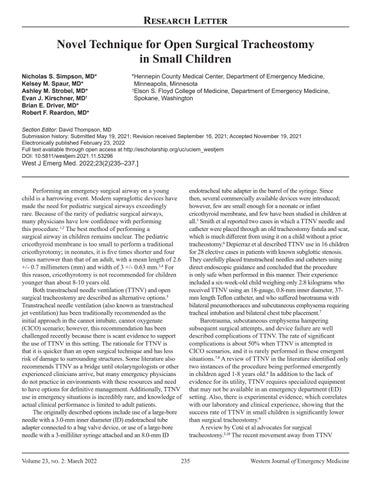Research Letter
Novel Technique for Open Surgical Tracheostomy in Small Children Nicholas S. Simpson, MD* Kelsey M. Spaur, MD* Ashley M. Strobel, MD* Evan J. Kirschner, MD† Brian E. Driver, MD* Robert F. Reardon, MD*
*Hennepin County Medical Center, Department of Emergency Medicine, Minneapolis, Minnesota † Elson S. Floyd College of Medicine, Department of Emergency Medicine, Spokane, Washington
Section Editor: David Thompson, MD Submission history: Submitted May 19, 2021; Revision received September 16, 2021; Accepted November 19, 2021 Electronically published February 23, 2022 Full text available through open access at http://escholarship.org/uc/uciem_westjem DOI: 10.5811/westjem.2021.11.53296
West J Emerg Med. 2022;23(2)235–237.]
Performing an emergency surgical airway on a young child is a harrowing event. Modern supraglottic devices have made the need for pediatric surgical airways exceedingly rare. Because of the rarity of pediatric surgical airways, many physicians have low confidence with performing this procedure.1,2 The best method of performing a surgical airway in children remains unclear. The pediatric cricothyroid membrane is too small to perform a traditional cricothyrotomy; in neonates, it is five times shorter and four times narrower than that of an adult, with a mean length of 2.6 +/- 0.7 millimeters (mm) and width of 3 +/- 0.63 mm.3,4 For this reason, cricothyrotomy is not recommended for children younger than about 8-10 years old. Both transtracheal needle ventilation (TTNV) and open surgical tracheostomy are described as alternative options.5 Transtracheal needle ventilation (also known as transtracheal jet ventilation) has been traditionally recommended as the initial approach in the cannot intubate, cannot oxygenate (CICO) scenario; however, this recommendation has been challenged recently because there is scant evidence to support the use of TTNV in this setting. The rationale for TTNV is that it is quicker than an open surgical technique and has less risk of damage to surrounding structures. Some literature also recommends TTNV as a bridge until otolaryngologists or other experienced clinicians arrive, but many emergency physicians do not practice in environments with these resources and need to have options for definitive management. Additionally, TTNV use in emergency situations is incredibly rare, and knowledge of actual clinical performance is limited to adult patients. The originally described options include use of a large-bore needle with a 3.0-mm inner diameter (ID) endotracheal tube adapter connected to a bag valve device, or use of a large-bore needle with a 3-milliliter syringe attached and an 8.0-mm ID
Volume 23, no. 2: March 2022
endotracheal tube adapter in the barrel of the syringe. Since then, several commercially available devices were introduced; however, few are small enough for a neonate or infant cricothyroid membrane, and few have been studied in children at all.3 Smith et al reported two cases in which a TTNV needle and catheter were placed through an old tracheostomy fistula and scar, which is much different from using it on a child without a prior tracheostomy.6 Depierraz et al described TTNV use in 16 children for 28 elective cases in patients with known subglottic stenosis. They carefully placed transtracheal needles and catheters using direct endoscopic guidance and concluded that the procedure is only safe when performed in this manner. Their experience included a six-week-old child weighing only 2.8 kilograms who received TTNV using an 18-gauge, 0.8-mm inner diameter, 37mm length Teflon catheter, and who suffered barotrauma with bilateral pneumothoraces and subcutaneous emphysema requiring tracheal intubation and bilateral chest tube placement.7 Barotrauma, subcutaneous emphysema hampering subsequent surgical attempts, and device failure are well described complications of TTNV. The rate of significant complications is about 50% when TTNV is attempted in CICO scenarios, and it is rarely performed in these emergent situations.7,8 A review of TTNV in the literature identified only two instances of the procedure being performed emergently in children aged 1-8 years old.8 In addition to the lack of evidence for its utility, TTNV requires specialized equipment that may not be available in an emergency department (ED) setting. Also, there is experimental evidence, which correlates with our laboratory and clinical experience, showing that the success rate of TTNV in small children is significantly lower than surgical tracheostomy.9 A review by Coté et al advocates for surgical tracheostomy.3,10 The recent movement away from TTNV
235
Western Journal of Emergency Medicine
